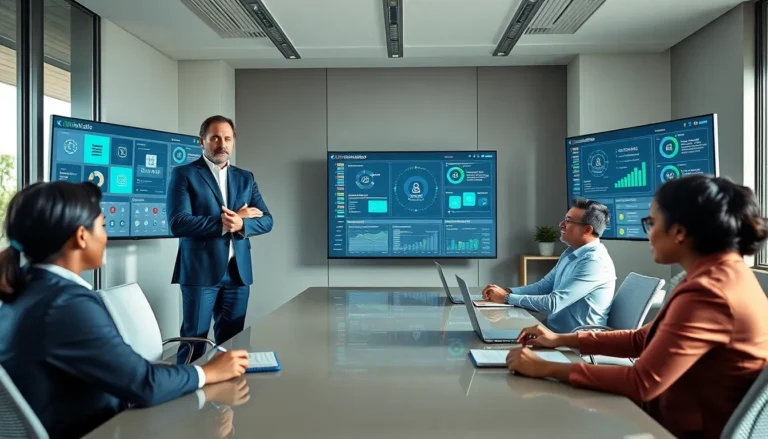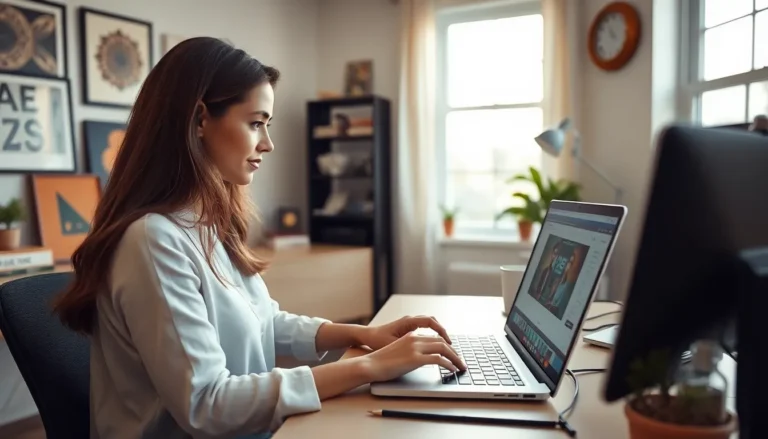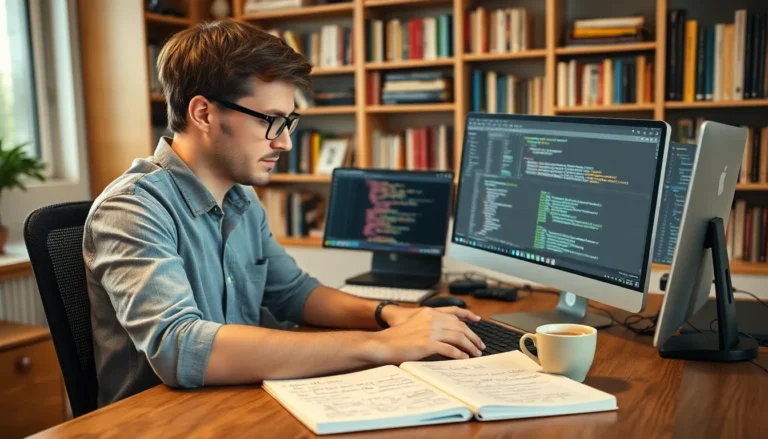Table of Contents
ToggleIn a world where creativity knows no bounds, the concept of “Design Parallels” emerges like a quirky twin that’s just as stylish but with a unique flair. Ever noticed how some design elements seem to dance together, even when they’re worlds apart? From architecture to graphic design, these parallels create a visual symphony that can leave anyone saying, “Wow, I never thought of it that way!”
Overview of Design Parallels
Design Parallels illustrate the interconnectedness of design across diverse fields. Architecture principles resonate in graphic design, blurring the lines between these disciplines. Patterns in forms and layouts can create an enchanting synthesis, enhancing visual language. Various design elements, such as symmetry and balance, manifest in both realms, proving that effective design transcends boundaries.
Architects often draw inspiration from visual arts, integrating practical functionality with aesthetic appeal. Graphic designers apply these architectural principles, constructing compelling compositions that engage viewers. Common themes appear across industries, incorporating use of color theory, typography, and spatial relationships. These elements serve as a foundation for creating impactful designs.
Exploration of design parallels reveals unexpected relationships. For instance, nature often influences both architectural and graphic designs, showcasing organic shapes and patterns. Designers can emulate natural forms to evoke emotion, establishing compelling narratives. Successful projects leverage these parallels to convey messages, ensuring designs resonate deeply with audiences.
Collaborative efforts among designers from various backgrounds often reveal innovative perspectives. Projects that blend architecture and graphic design exhibit unique visual identities. This cross-pollination fosters creativity, producing solutions that address contemporary challenges.
Each design field contributes to a broader understanding of visual communication. Analyzing these parallels enriches the design process, encouraging practitioners to rethink their approaches. Design parallels become a source of inspiration, promoting a cohesive experience that inspires both creators and consumers.
Historical Context

Design parallels have roots in historical contexts that illustrate the evolution of design practices over time. Connections between disciplines reveal an ongoing dialogue among creators that spans centuries.
Evolution of Design
Early design emerged from necessity, with artisans crafting functional objects. Over time, aesthetics gained importance alongside utility, leading to an interplay between form and function. The Industrial Revolution marked a significant turning point, introducing mass production and democratizing design. This shift enabled widespread access to formerly exclusive artistic styles. Mid-20th century modernism championed simplicity and minimalism, emphasizing clean lines and organic forms. Contemporary design draws from these principles, incorporating technology and sustainability, reflecting current cultural values. As a result, designers across fields increasingly find inspiration in historical trends while pushing the boundaries of innovation.
Key Influences
Cultural movements significantly impact design, shaping aesthetics and ideologies. The Bauhaus movement emphasized the unity of art and technology, encouraging interdisciplinary collaboration. In contrast, Postmodernism challenged conventional norms, embracing eclectic styles and historic references. Nature serves as another essential influence, as organic structures and forms evoke human emotion and connection. Technological advancements have also transformed design practices, enabling new tools and mediums for expression. Designers increasingly draw from diverse influences, recognizing the interconnectedness of disciplines. The ongoing exchange of ideas fosters creativity, allowing for innovative solutions that address modern challenges effectively.
Types of Design Parallels
Design parallels manifest across various disciplines, highlighting the interconnectedness of creative practices. Each type encompasses distinct elements that contribute to a cohesive visual language.
Graphic Design Parallels
Graphic design parallels often incorporate principles from other design fields, enhancing visual storytelling. Symmetry and balance frequently appear in layouts and compositions. Many graphic designers draw inspiration from architectural structures, using strong lines and geometric shapes to create engaging visuals. Color schemes also play a crucial role; the choice of colors can evoke specific emotions and convey narratives. Elements like typography benefit from architectural influences, integrating functionality with aesthetic appeal. Overall, graphic design thrives by borrowing concepts, emphasizing the unity across creative disciplines.
Product Design Parallels
Product design parallels reveal how aesthetics and functionality intertwine to create user-centered solutions. Ergonomics, an essential aspect of product design, reflects architectural considerations of space and user interaction. Materials used in products often mirror natural forms found in environmental design, promoting sustainability. Designers frequently explore innovative uses for everyday items, inspired by visual culture and trends in graphic design. Collaboration between product designers and other artists fosters new perspectives and pushes creative boundaries. As a result, products embody a blend of beauty and practicality, showcasing the interconnected nature of design.
Architectural Design Parallels
Architectural design parallels emphasize the relationship between structure and environment, drawing from principles in graphic and product design. Elements such as form and function resonate across different design realms. Architects often incorporate natural elements into their designs, inspired by organic shapes observed in graphic art. Collaborations among architects, graphic designers, and product creators allow for inventive approaches to space and structure. The use of technology enhances architectural possibilities, echoing trends seen in contemporary design practices. Ultimately, architecture reflects a dialogue between aesthetics and usability, enriching the design landscape.
Case Studies
Design parallels manifest in various real-world applications, illustrating the principle across diverse fields.
Notable Examples
One standout example involves the work of Zaha Hadid, whose architectural designs reflect fluid forms found in nature. Her buildings often mirror elements of graphic design, showcasing dynamic shapes and lines. Similarly, Yves Behar’s product designs, like the Snoo bassinet, seamlessly blend functionality with aesthetics. In graphic design, the album covers by Peter Saville highlight the integration of architectural principles, using bold layouts and symmetry to enhance visual storytelling. Each of these examples emphasizes how distinct design disciplines can inspire and elevate one another, creating compelling results.
Lessons Learned
Understanding design parallels promotes innovation across disciplines. They showcase the significance of borrowing concepts from various fields. Analyzing successful projects encourages designers to think outside conventional boundaries. Embracing collaboration leads to fresh perspectives and creative solutions. Observing the interplay between aesthetic appeal and functionality directly influences user experience. Ultimately, synthesizing ideas from architecture, graphic design, and product design fosters a holistic approach to modern challenges. These insights reinforce the value of interconnectedness in the design landscape.
Future Trends in Design Parallels
In the coming years, Design Parallels will likely evolve further, influenced by advancements in technology and shifts in cultural paradigms. Digital tools will enhance collaborative efforts among architects, graphic designers, and product creators, facilitating innovative workflows. Increased emphasis on sustainability will shape design choices, promoting eco-friendly materials across all design disciplines.
Artificial intelligence will play a pivotal role in generating design solutions, enabling designers to explore diverse styles and applications with ease. This technology will optimize processes, making it possible to customize designs for specific user needs and preferences. User experience will take center stage, pushing designers to engage audiences through emotional storytelling and interactive elements.
Cross-disciplinary collaborations will gain traction, integrating diverse perspectives and skills. As designers pool their talents, they will challenge conventional practices and embrace experimentation. Influences from nature will continue to inspire creative approaches, leading to organic forms that resonate emotionally with users.
Cultural movements will remain significant, fostering dialogues among creators that reflect societal values. The influence of minimalist aesthetics will persist, as simplicity and functionality become essential in responses to modern complexities. Multisensory design experiences will rise, engaging audiences on auditory and tactile levels alongside visual appeal.
Overall, embracing these trends will highlight the interconnectedness of design disciplines. Designers will navigate future challenges by adopting holistic approaches that blend functionality, aesthetics, and user-centered solutions.
Design Parallels reveal the intricate web connecting various design disciplines. By embracing these relationships, designers can unlock new levels of creativity and innovation. The blending of architectural principles with graphic and product design not only enhances visual storytelling but also fosters user-centered solutions.
As technology advances and cultural values shift, the potential for collaboration among designers will only grow. This interconnectedness will continue to inspire fresh ideas and approaches. Ultimately, understanding and exploring Design Parallels will empower creators to navigate the complexities of modern design, ensuring that aesthetics and functionality work hand in hand.




